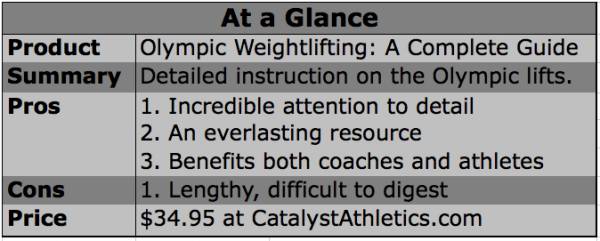

I first met Greg Everett… Well, now that I think of it, I haven’t met him. I just feel like I have because of the incredible number of times I’ve listened to him and Robb Wolf on the Paleo Solution Podcast. Though both he and Robb both can assume this position, Greg Everett stands out in my mind as the reluctant genius. His ability to navigate his own wealth of knowledge with regards to nutrition, performance, and weightlifting seems to come so easily that discussing such matters seems like it bores him, at least on the podcast.
Everett’s iconic book titled Olympic Weightlifting: A Complete Guide for Athletes & Coaches is a “go to” resource for weightlifting in text form. I can’t begin to tell you how many of my coaches’ bookshelves I’ve seen this gem on. In a nostalgic way, it elicits the type of authority that a similar but different text I had as kid growing up did. It went by the name of Nolan Ryan’s Pitching Bible.
Though I am no Greg Everett I do know my way around a barbell, and as I initially thumbed through the text I became anxious just thinking about all the potential rabbit holes of intricate details that the Olympic lifts make available. Entire volumes could be written on each of the three pulls, or major segments of the movements.
A separate volume of work could be devoted to the ideology of efficiency, the laws of nature, and weightlifting’s attempt to maneuver the two. When you title a book Olympic Weightlifting: A Complete Guide for Athletes & Coaches, you are committing yourself to providing a great depth of information, so much so that I started my experience with the text wondering which areas Mr. Everett would carefully choose to omit or neglect. As you will soon learn, I was surprised to find that nearly every conceivable stone was, in fact, unturned.
Like any good text, Everett’s book lays the groundwork for Olympic lifting with an opening section on foundations. Here the reader welcomes, potentially for the first time, a general look at physics with the Law of Inertia, the Law of Acceleration, and the Law of Reciprocal Actions. Once explained to them in layman’s terms, most readers will advance quickly with a new name for something they’ve long understood.
The book then dives into a long linear journey that begins as elementary as describing the equipment down to the collars and knee sleeves. From there, easily overlooked and under respected content about proper warm ups is outlined in beautiful detail with descriptive images to go along.
Pleasingly, I found that the first mention of an exercise thereafter was, most simply, the squat. It’s here I began to recognize Greg’s voice coming through in a brief, but educational diatribe into squat depth and the stir it still causes in circles outside of the sport of weightlifting.
It’s this genuine voice that I enjoy about Greg that I hear so clearly in his work with the Paleo Solution Podcast. Like all the sections of this text, Greg includes exceptions, modifications, and a multitude of explanations of how and why things may occur less than optimally.
Like in the squat section, each section thereafter includes coaching cues and relevant mobilizations and activations. The snatch, for example, covers nearly fifty pages on instruction. Breaking down the starting positions, execution, finish, and various progressions for the clean, the snatch, the jerk, and the clean and jerk begins to lay out a language to the reader, if he/she hasn’t had previous experience with the lifts.
This language and the relevant progressions outlined in the movement chapters make the subsequent section that addresses common faults and fixes a breeze. “Starting position” and “third pull” have meaning now, whether Greg’s making reference to the snatch or the clean.
After a thorough examination of the movements and common faults, the text moves into programming. Another impressive note about this text is that Everett covers so much content the book is impactful no matter what the level of competency of the reader. So, even if weightlifting isn’t new for you, anyone can get something from this section. As a coach, this section will be one I will refer back to often as a resource for developing programs for different types of athletes.
If that wasn’t enough, Everett offers an opportunity to get a bit of extra credit with a full section of supplemental exercises and skill transfer drills. The book then closes with an overview of nutrition, supplementation, flexibility measures, and even a dive into the intricacies of weightlifting competition. I’ve always wondered how lifters and their coaches plan attempts and the strategy of the sport of weightlifting.
It’s quite easy to become overwhelmed with a book like this, but it’s just too good not to own. Everyone who reads it will get better (as an athlete or a coach). There’s no doubt about that. The most practical use for this book, in my opinion, is as a resource. Whether you’re a hobbyist who likes weightlifting or you are a professional coach, this text will be one to thumb through, refer back to, and crosscheck ideas with for years and years.
“Olympic Weightlifting: A Complete Guide for Athletes & Coaches” is available at CatalystAthetlics.com for $34.95.
Read a review of Greg Everett’s second book, “Olympic Weightlifting for Sports.”
Want to train like Greg’s athletes? Follow his three weeks of free workouts.






